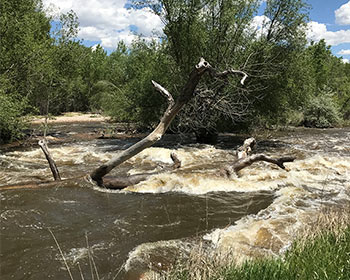Better Bridge And Culvert Designs Flow From Improved Hydrologic Analyses
Posted: Sep 17, 2020
 MPC researchers at Colorado State University are improving the hydrologic analyses used to evaluate dam safety and to design bridges and roads. Many current hydrologic guidelines assume that runoff from design storms is produced by an infiltration-excess mechanism where rainfall intensity exceeds the infiltration capacity of the soil. However, mountain basins often have shallow soils. In such cases, saturation-excess runoff might occur when the entire soil becomes saturated. Saturation-excess occurs when rain falls on a location that is completely saturated from a low-permeability layer up to the soil surface. Neglecting saturation-excess runoff might lead to inaccurate hydrologic analyses. The researchers examined the hydrologic response of five Colorado Front Range basins for several historic flood events. They used computer models to determine which run-off mechanisms likely produced observed stream flows. They found that shorter duration but more intense design storms tend to produce infiltration-excess runoff, while less intense but longer design storms tend to produce saturation-excess runoff.
MPC researchers at Colorado State University are improving the hydrologic analyses used to evaluate dam safety and to design bridges and roads. Many current hydrologic guidelines assume that runoff from design storms is produced by an infiltration-excess mechanism where rainfall intensity exceeds the infiltration capacity of the soil. However, mountain basins often have shallow soils. In such cases, saturation-excess runoff might occur when the entire soil becomes saturated. Saturation-excess occurs when rain falls on a location that is completely saturated from a low-permeability layer up to the soil surface. Neglecting saturation-excess runoff might lead to inaccurate hydrologic analyses. The researchers examined the hydrologic response of five Colorado Front Range basins for several historic flood events. They used computer models to determine which run-off mechanisms likely produced observed stream flows. They found that shorter duration but more intense design storms tend to produce infiltration-excess runoff, while less intense but longer design storms tend to produce saturation-excess runoff.
The study identified a key limitation in some current hydrologic guidelines. It also suggests this limitation can be overcome by applying the hydrologic modeling techniques used in the study. Thus, the research is expected to lead to more accurate estimates of runoff and streamflow from design storms and improved hydrologic analysis and design for dams, bridges, and culverts.
Jeffrey D. Niemann, Ph.D.
Colorado State University
Quantifying Mountain Basin Runoff Mechanisms for Better Hydrologic Design
MPC-20-419